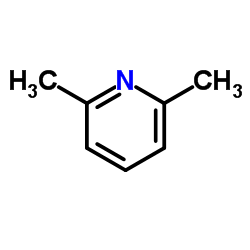2,6-lutidine

2,6-lutidine structure
|
Common Name | 2,6-lutidine | ||
|---|---|---|---|---|
| CAS Number | 108-48-5 | Molecular Weight | 107.153 | |
| Density | 0.9±0.1 g/cm3 | Boiling Point | 144.0±0.0 °C at 760 mmHg | |
| Molecular Formula | C7H9N | Melting Point | -6 °C | |
| MSDS | Chinese USA | Flash Point | 33.3±0.0 °C | |
| Symbol |


GHS02, GHS07 |
Signal Word | Warning | |
|
High-throughput chemical modification of oligonucleotides for systematic structure-activity relationship evaluation.
Bioconjug. Chem. 25(12) , 2222-32, (2014) Chemical modification of siRNA is achieved in a high-throughput manner (96-well plate format) by copper catalyzed azide-alkyne cycloadditions. This transformation can be performed in one synthetic operation at up to four positions with complete specificity, g... |
|
|
Ambient preparation and reactions of gas phase silver cluster cations and anions.
Phys. Chem. Chem. Phys. 17 , 18364-73, (2015) Electrospray ionization of metal salt solutions followed by ambient heating transforms the resulting salt clusters into new species, primarily naked ionic metal clusters. The experiment is done by passing the clusters through a heated coiled loop outside the ... |
|
|
Sugar composition of the pectic polysaccharides of charophytes, the closest algal relatives of land-plants: presence of 3-O-methyl-D-galactose residues.
Ann. Bot. 116 , 225-36, (2015) During evolution, plants have acquired and/or lost diverse sugar residues as cell-wall constituents. Of particular interest are primordial cell-wall features that existed, and in some cases abruptly changed, during the momentous step whereby land-plants arose... |
|
|
Photolithographic Synthesis of High-Density DNA and RNA Arrays on Flexible, Transparent, and Easily Subdivided Plastic Substrates.
Anal. Chem. 87 , 11420-8, (2015) The photolithographic fabrication of high-density DNA and RNA arrays on flexible and transparent plastic substrates is reported. The substrates are thin sheets of poly(ethylene terephthalate) (PET) coated with cross-linked polymer multilayers that present hyd... |
|
|
Self-assembled hybrid metal oxide base catalysts prepared by simply mixing with organic modifiers.
Nat. Commun. 6 , 8580, (2015) Multidentate materials formed by simply mixing heterogeneous and homogeneous components are promising for construction of versatile active sites on the surface of heterogeneous compounds, however, to the best of our knowledge, there are no reports on such mat... |
|
|
Activity of core-modified 10-23 DNAzymes against HCV.
ChemMedChem 9(9) , 2172-7, (2014) The highly conserved untranslated regions of the hepatitis C virus (HCV) play a fundamental role in viral translation and replication and are therefore attractive targets for drug development. A set of modified DNAzymes carrying (2'R)-, (2'S)-2'-deoxy-2'-C-me... |
|
|
Multi-modal detection of colon malignancy by NIR-tagged recognition polymers and ultrasound contrast agents.
Int. J. Pharm. 478(2) , 504-16, (2015) To increase colonoscopy capability to discriminate benign from malignant polyps, we suggest combining two imaging approaches based on targeted polymeric platforms. Water-soluble cationized polyacrylamide (CPAA) was tagged with the near infrared (NIR) dye IR-7... |
|
|
Asymmetric fluorination of alpha-aryl acetic acid derivatives with the catalytic system NiCl2-Binap/R3SiOTf/2,6-lutidine.
Angew. Chem. Int. Ed. Engl. 46(28) , 5435-9, (2007)
|
|
|
Effect of base pairing on the electrochemical oxidation of guanine.
J. Am. Chem. Soc. 132(29) , 10142-7, (2010) The effect of base pairing by cytosine on the electrochemical oxidation of guanine is examined by means of cyclic voltammetry on carefully purified reactants in a solvent, CHCl(3), which strongly favors the formation of an H-bonded pair. The thermodynamics an... |
|
|
Reactivity of 2,6-lutidine/BR₃ and pyridine/BR₃ Lewis pairs (R = F, Me, C₆F₅): a density functional study.
J. Phys. Chem. A 114(43) , 11738-45, (2010) The reactivity of 2,6-lutidine/BR₃ and pyridine/BR₃ Lewis pairs (R = F, Me, C₆F₅) is investigated in detail by quantum chemical calculations. The observed reactivity difference of these pairs is interpreted in terms of the existence of a "frustrated complex" ... |